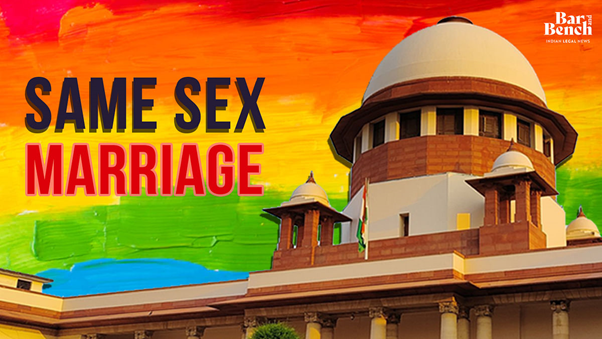The day after, a disquiet
In the same-sex marriage verdict, principles on which the majority on the bench has proceeded suggest a narrow, technical approach, which could have been avoided on a minority right.
Relevance
- GS Paper 2 Constitution of India —historical underpinnings, evolution, features, amendments, significant provisions and basic structure.
- Separation of powers between various organs dispute redressal mechanisms and institutions.
- Tags: #samesexmarraige #LGBTQ+ #CJI #india #SC #currentaffairs #upsc.
Why in the News?
Chief Justice D Y Chandrachud and four of his esteemed colleagues gathered to deliver a landmark judgment concerning what has become widely known as “same-sex marriage” in India.
This judicial decision, born out of weeks of legal debates, scrutinized the extent of marriage laws in the country and their applicability to relationships within the LGBTQ+ community. Beyond the scope of marriage itself, the case raised profound questions about civil rights, including inheritance, adoption, and property rights, as well as seemingly routine matters such as nominees for insurance, bank accounts, and medical claims.
Central Questions Framed by the Court
The central questions addressed by the Court were as follows:
- Does a fundamental right to marriage exist?
- Can the words in the Special Marriage Act be interpreted in a gender-neutral manner?
- Is it possible to legally recognize civil unions under Indian law?
- Can the State be obligated to acknowledge such relationships and, by extension, the associated rights?
Chief Justice Chandrachud’s Judgment
- As Chief Justice Chandrachud began reading the judgment, hope radiated from the benches of the petitioners. He reaffirmed the Court’s authority to examine these critical issues, rejecting the government’s objections.
- Delving into the essence of queerness, the Court underscored its deep-rooted presence in Indian culture, dispelling the notion that it was confined to urban or elite settings.
- Most significantly, although the verdict concluded that the right to marriage was not a fundamental right, it maintained that the right to enter into a union transcended sexual orientation and was embedded in the fundamental rights enshrined in Articles 19 and 21 of the Constitution.
- Consequently, a series of directives was issued to various authorities to eradicate discrimination against the LGBTQ+ community.
Justice Sanjay Kishan Kaul’s Perspective
- Justice Kaul’s concise 17-page judgment aligned with the Chief Justice’s views, recognizing the discriminatory nature of the Special Marriage Act due to its exclusive regulation of heterosexual relationships.
- However, Justice Kaul refrained from making interpretations that might directly benefit the LGBTQ+ community, apprehensive about the potential cascade of implications across various laws.
Differences on the Bench
- At this juncture, it became evident that differences existed among the judges, with both Justices Chandrachud and Kaul expressing their disagreements with the draft opinion presented by Justice S R Bhat. Justice Bhat, representing himself and Justice Kohli, concurred with the Chief Justice on the absence of a fundamental right to marriage.
- However, he maintained that a right to a relationship was safeguarded under Article 21 of the Constitution, though he refrained from extending this right further as Chief Justice Chandrachud did, such as discovering a right of self-development in Articles 19, 21, and 25 or obligating the State to legally recognize civil unions.
- Although he agreed with the Chief Justice regarding the validity of the Special Marriage Act, he remained unconvinced about the possibility of LGBTQ+ couples acquiring rights like adoption through judicial decisions. The majority was constituted by Justice Narasimha, aligning with Justices Bhat and Kohli.
Analysis and Concerns
- The rarity of the Chief Justice being part of the minority opinion, the decision to entrust a government committee with the responsibility of actualizing the community’s rights, the nuanced interplay between religion and sexual choice in interpreting core constitutional provisions, and the broader concept of judicial restraint all merit rigorous examination.
- This group of five judges constitutes some of the most learned, sensitive, intelligent, and empathetic individuals in the Supreme Court.
- Yet, even among these esteemed individuals, divergent opinions emerged regarding how to practically address the aspirations of the LGBTQ+ community who seek to lead ordinary lives devoid of harassment and obstacles. Fundamental human needs such as having a spouse, being a parent, entrusting, and aligning with others were at the core of this legal discourse.
A Missed Opportunity for the Court
- In choosing to defer to the legislature and executive, particularly the Committee proposed by the Solicitor General, it appears that the Court missed a significant opportunity to confront a pressing human issue.
- Over the decades, when various groups came before the Supreme Court advocating for the rights of undertrials, sexually harassed women in the workplace, voters deprived of candidate information, unregulated inter-country adoption, and the lack of oversight over the CBI, the Court promptly established guidelines until corresponding laws were established.
When fundamental rights such as the right to have a family, live with dignity, and the right to privacy are recognized under Article 21 of the Constitution, it is perplexing that non-heterosexual couples, and even unmarried heterosexual ones, must prove that the right to marriage is fundamental for them to access mechanisms to enjoy their civil rights. The approach adopted by the majority suggests a narrow and technical stance, an approach that could have been more inclusive and accommodating when addressing a minority right. In this respect, the Court may have missed an opportunity, an opportunity that it has embraced on numerous occasions, with potentially less at stake.
Sources: Indian Express
Mains Question:
The recent Supreme Court verdict on same-sex marriage in India has sparked significant debates and discussions. Analyze the key principles and arguments presented in the judgment. Discuss the implications of the verdict on the LGBTQ+ community and the broader societal context. Also, examine whether the Court’s approach was appropriate in addressing the rights of the LGBTQ+ community in India.




